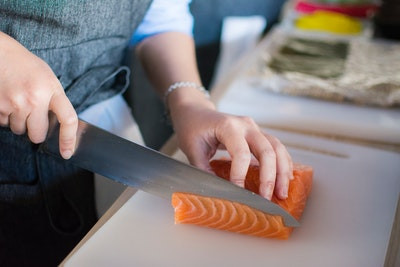11 October 2019
The truth about “poke bowl calories”: is it really a healthy meal choice?
Pronounced POE-KAY (to rhyme with OK), the poke bowl is a Hawaiian dish making waves as the culinary trend du jour. The poke bowl is often billed as a one-stop super healthy lunch option, but do you know what proportion of your daily calories it might contain? In this article we take a look at the origins of the poke bowl, its typical ingredients and how many calories you can expect to find in your favorite salmon or tuna poke bowl.
Poke bowl calories
The average poke bowl can contain anywhere from 500-1000 calories. That’s a huge range, and if you’re following a weight loss program, you’ll want to ensure that your poke bowl is lying somewhere at the lower end of the scale. Assuming a daily total calorie consumption of around 2000 kcals, you should be having around 700 of those calories in your midday meal. Whether you prefer a salmon poke or a tuna one isn’t the issue, as the calorific profiles of these two oily fish don’t vary dramatically. But a single serve of a creamy dressing can add as much as 200-300 kcals to your poke, drowning your healthy calories in saturated fat and excess calories.
Poke bowl calories: how this dish went mainstream
From its humble origins as a fisherman’s dish consisting of the chopped raw catch of the day, seasoned and mixed with seaweed, the poke has been exported all over the globe, picking up regional influences along the way and undergoing the kind of total transformation you would expect from such an experienced traveler. From soy sauce, sesame oil and nori to spicy sauce or dried fruit and nuts, the poke bowl truly represents an international melting pot of flavors. It’s a trend that doesn’t show any signs of slowing down either, with poke bars branching out from the larger metropoles and into the suburbs. The poke is appealing as a quick lunch option, with many restaurants offering a customizable, self-assembly poke experience allowing you to build up your own poke according to how you feel on the day!
Read also: How many calories should I eat a day?
A versatile all-rounder

Whatever the specific combination of ingredients, at the core are a handful of basic components that are found at the heart of every poke bowl. First, a base of healthy carbs – usually rice (swap in brown for a slower-digesting, healthier option) but you can also opt for quinoa or grains. On top of your chosen carbs, go salad leaves, chopped raw veg, even seeds and toasted nuts. Finally, a decent serve of the freshest dice fish, perhaps a sprinkle of black sesame and you’re good to go. Whether you’re a purist who likes to keep each ingredient separate or whether you prefer to experiment and mix it up – how you eat it is up to you!
So, the million-dollar question – how healthy is your poke bowl?
Like many a dish, the poke bowl can be found in a multitude of guises and variations. By now you’ll probably have come to the conclusion that there are as many different versions as there are eaters of poke bowls – which makes it somewhat challenging to give a verdict as to how healthy they are. The building blocks of the classic poke bowl are as healthy as they come, with rice or grains providing carbs and fiber for energy and digestion, a variety of fresh veg providing a rainbow of vitamins and antioxidants and oily fish guaranteeing a valuable dose of omega fatty acids. However, the poke bowl’s evolution has seen it attract a variety of different seasonings and sauces from chefs and food outlets keen to put their own spin on this traditional dish.
Read also: Acai bowl calories: here is what you should know
Poke calories: Watch the sauce
It’s probably not going to be so much a case of what’s in the bowl, so much as what you put on it. Whilst many seasonings and sauces are relatively low in calories and fat, there are some major culprits out there. You may have seen creamy, white, mayo-based sauces on offer, with an herby or garlicky flavor, like aioli. These are guaranteed to change the profile of your healthy poke bowl – for the worse. Shoyu or soy-based dressings are more liquid in consistency and lower in fat but are likely to contain relatively high levels of salt – something to be aware of if blood pressure is an issue for example. Use sparingly to enhance the flavors of the raw ingredients.
You don’t need to be a calorie-counting math wizard to make sensible and healthy poke choices, however. As a basic rule of thumb, ensure the contents of your poke would fit into your cupped hands and steer clear of the creamier sauces. Now go poke!
Did you enjoy this article? Share it!

